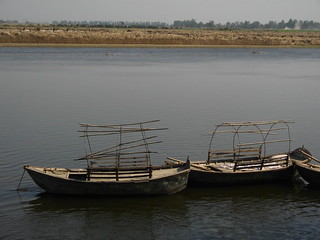The Ganga is the most sacred river in the sub-continent, and revered by millions.It is also among the top ten rivers at risk. The key threat to the river is indiscriminate abstraction of water from the river, leavng it unable to maintain its ecological integrity or to satisfy the needs of riparian communities. In 2008, WWF, in association with various partners, embarked on an exercise to assess the environmental flow requirements of the Ganga, using the Building Block Methodology as part of its Living Ganga Programme. This method takes into accounts various ecological and human needs of the river. This article presents the report brought out by WWF on 'Assessing flow requirements for the Upper Ganga'

The concept of environmental flows and overview of estimation methodologies
The threats to rivers, concept of environmental flows, and the need for these are discussed in this section. It defines e-flows as a pattern of flows required by a river to maintain itself in a desired envrionmental condition.E-flow assessment aims at ensuring that there are sufficient flows, in near-natural flow patterns to maintain the health of the river. Several estimation methodologies have been developed, from the most basic desktop assessments to rigorous analyses. An overview of these methodologies is presented in this paper, after grouping them as look-up tables, hydrological model, extrapolation model, hydraulic rating, habitat simulation, holistic, 'see what happens' and 'upside down'.
EFA process and rationale
One of the objectives of this project was capacity building of a local team to asssess environmental flows using a holistic method, in this case, the Building Block Methodology (BBM). The upper stretch of the Ganga, from Gangotri to Kanpur was selected for this process. The team did assessment of e-flows considering various components or 'building blocks':Hydrology, hydraulics, fluvial geomorphology, biodiversity, water quality, liveligooods, cultural and spiritual.
Zonation and site selection
The richly varied and vastly threatened upper stretch of the Ganga was selected for the study. It was divided into seven largely homogenous zones for study. Of these seven, four zones were selected to represent the following properties: mountainous, relatively intact, affected by water abstraction, affected by pollution. The following four zones were finally selected:
Zone 1: Gangotri to Rishikesh;
Zone 2: ( A reference zone) from upstream of Garhmukteshwar to Narora;
Zone 3: Narora to Farrukhabad, and
Zone 4: Kannauj to Kanpur
One sample site (or section) was selected in each zone for study. The paper describes these zones and sample sites in detail including location, biodiversity, sociocultural and livelihood aspects, pollution issues.
The present state and environmental objectives for the upper Ganga river
The various specialist groups assessed the four zones at the sections described above. Their assessment of the current state, and objectives set for the desired state are explained in this section. This is a data-rich section with information on water abstractions, pollution, and other information related to the Ganga on this stretch, but particularly with respect to the selected sites. Simulations of the natural flow conditions are presented in the form of graphs and tables. Results of water quality tests, biodiversity surveys, livelihood and spiritual importance surveys, are all presented for each zone.
Recommended flows for the upper Ganga: process and results
After determining a desired state, the specialist groups recommended the desired flows for the component they were studying. High and low flows, with annual and periodical floods, were recommended for regular and drought years with justification. The flows finally selected for the regime was arrived at by consensus. Using these- the 'critical' flow recommendations- the e-flow values were interpolated by the hydrologist for the remaining months of the year to arrive at the recommended flow regime. The following point,emphasized in the report is critical: E-Flows are actually a pattern of flows: In addition to annual MAR percentages, the monthly and seasonal flow requirements, depicted on the graphs, should be noted. Details of the flows recommended by the various groups for each site are presented, as are the final flow regimes.
The way forward
The work carried out so far has provided a detailed case study of the field-besed assessment of e-flows in India. This section details the challenges that need to be addressed for future e-flows assessment and implementation. Lack of data is the primary concern for assessment. The challenges for implementation are over-allocation of flows, rationalisation of which require drastic intervention and commmittment. The section also makes suggestions for this re-allocation and for managing the required flow regime.